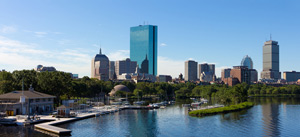
Boston
Green Burial in Greater Boston and New England
In Boston, green burial is one of those everything-old-is-new-again notions. Boston has cemeteries that date from before the Civil War, when all burials were green. Pine box into the ground and there you go. Very straightforward. These days, the guiding principle of going easy on the land has various interpretations. The basics involve expedient natural decomposition and steering clear of burying items that will be there for centuries to come or that will somehow pollute the ground, to wit: steel, concrete, plastics and chemicals.
Green cemeteries do not allow embalming fluids, nonbiodegradable caskets, or permanent grave liners or vaults. Green cemeteries seek to promote the natural decomposion of a body. Some environmentalists, such as the founders of the Green Burial Council, tie green burial to wide, open spaces and a concept of land preservation.
Conventional cemeteries -- and Massachusetts requires each town to provide burial space for its citizens -- require grave liners or vaults to maintain ground stability and allow the use of machinery to open and close graves. Formaldehyde, the key ingredient in embalming fluid, is now identified as a known human carcinogen by the International Agency for Research on Cancer and a probable human carcinogen by the U.S. Environmental Protection Agency. That is, funeral home workers exposed to embalming fluid are at risk for their health.
An effort to return to green burial in Massachusetts is under way with three state Funeral Consumer Alliance chapters working together and with Massachusetts land trusts -- of which there are many -- to secure a land deal. Acreage under scrutiny lies in Northeast Massachusetts. In Massachusetts, all cemeteries must be approved by the Department of Health, so public meetings will be held. Current thinking holds that once the first green burial site is opened, others will follow.
Meantime, some of Boston's established cemeteries will work with clients. Mount Auburn in Cambridge has made a trial run of burying an "ecopod" casket -- so far no one has brought one in for real -- and will adapt grave-liner requirements as possible to accommodate requests. Sometimes, this means installing the liner upside down so that the casket rests on earth but the liner protects the grave from cave-in when cemetery equipment digs nearby graves. Because Mount Auburn does not section off areas per sect, administrators do not foresee developing space available for green burials only.
If you're adamant about finding a dedicated green burial ground, New York has a Green Burial Council-certified ground in Newfield, near Ithaca. Greensprings Natural Cemetery is 280 miles west of Boston.
Maine offers Cedar Brook Burial Ground at Limington, Maine, near Portland and 103 miles from Boston. Rainbow's End Natural Cemetery is in South Orrington, near Bangor, which is 238 miles from Boston. Contact manager Joan Howard, 48 Mill Creek Road, Orrington, ME 04474, or JoanHoward@att.net.
Green cemeteries such as Greensprings seek to preserve a natural, unmussed landscape. Many such cemeteries let visitors use GPS tracking devices to locate remains of loved ones. Traditional headstones are replaced by natural rocks, the sort that might have been left by glacial retreat millennia ago.
The Green Burial Council certifies three levels of burial grounds:
Conservation burial grounds are green cemeteries that partner with an established conservation group, hold conservation easements on the property, and operate on principles of restoration ecology.
Natural burial grounds are green cemeteries that must engage in restoration planning and land stewardship. A natural burial ground needn't hold a conservation easement, but it must use deed restrictions or covenants that keep the land as a green cemetery.
Hybrid burial grounds combine conventional practices with green aspirations. In some instances, this means vaultless burials. In other cases, land-use principles come into play.
